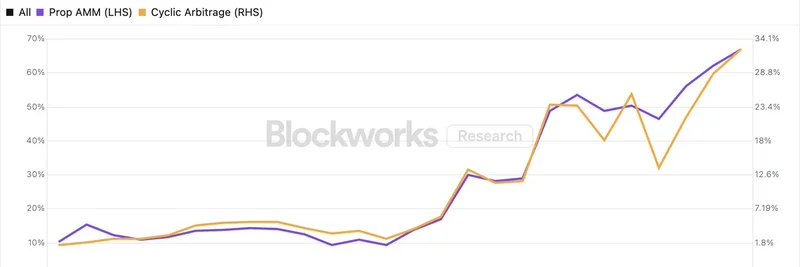In the fast-paced world of Solana's decentralized exchanges (DEXs), a subtle shift is reshaping how traders hunt for profits. Proprietary Automated Market Makers (Prop AMMs) are stepping up, turning traditional arbitrage plays into something more streamlined and onchain. If you're into meme tokens on Solana—like those viral pumps that can make or break a portfolio—this trend could open up new edges in your trading game.
Understanding Prop AMMs and Their Edge
First off, let's break down the basics. Automated Market Makers (AMMs) are the backbone of DEXs, providing liquidity for trades without needing a traditional order book. Public AMMs, like those on Uniswap or Raydium, are passive—they rely on liquidity providers to set pools and let market forces adjust prices.
Prop AMMs, on the other hand, are run by professional market makers who actively quote prices. Think of them as the pros bringing centralized exchange (CEX) efficiency to the blockchain. They use sophisticated algorithms, often factoring in CEX mid-prices from places like Binance, to offer tighter spreads and better rates. On Solana, platforms like Jupiter, DFlow, and Titan are leading this charge through their aggregator integrations.
The key twist? Prop AMMs are mostly accessible via DEX aggregators, which scan multiple sources for the best deal. This setup creates ripe conditions for atomic arbitrage—trades that happen in a single, unbreakable transaction onchain.
From CEX-DEX Arb to Atomic Cycles
Traditionally, arbitrage between CEXs and DEXs involved latency risks: buy low on one, sell high on the other, and hope nothing slips in between. But with Prop AMMs mirroring CEX prices more proactively, that offchain leg is getting replaced by fully onchain loops.
As Sharples from Blockworks Research points out in a recent thread, this shift is evident in the data. As Prop AMM volume climbs, so does the share of aggregator traffic dedicated to cyclic arbitrage—those quick, looped trades that exploit tiny price discrepancies across pools.
The chart above, sourced from Blockworks Research, illustrates this perfectly. The purple line tracks Prop AMM dominance (left axis), surging from around 10% in late 2023 to over 30% by mid-2025. Meanwhile, the orange line (right axis) shows cyclic arbitrage volume following suit, peaking at similar highs.
Spotlight on Key Players: Jupiter, DFlow, and Titan
Diving deeper, Sharples highlights how specific aggregators are capturing this arb flow:
Jupiter: Solana's go-to aggregator for meme token swaps, known for its speed and vast liquidity routes.
DFlow: A rising star focusing on order flow auctions, making it a hotspot for searchers sniffing out arb ops.
Titan: Another contender optimizing for high-volume, low-latency trades.
These platforms are seeing a influx of "searchers"—bots and traders scanning for inefficiencies. Why the boost? Prop AMMs' active pricing means more frequent misalignments between onchain markets, all resolvable in one atomic tx. No more waiting for CEX confirmations or risking slippage.
In a reply to the thread, Vaibhav from Socket Labs asked why Prop AMMs specifically drive this. Sharples explained: They're aggregator-exclusive, their prices are dynamic (often tied to CEX benchmarks), and they make atomic arbs more efficient with revert protection and low fees. Overall arb volume might not spike dramatically, but the onchain portion sure is.
Implications for Meme Token Traders
For meme token degens on Solana, this evolution is huge. Meme coins thrive on volatility, and tighter liquidity from Prop AMMs means smoother entries and exits—even during those wild pumps. Cyclic arbitrage keeps prices aligned, reducing the spreads that can eat into your gains.
But it's not just about trading; it's about the ecosystem maturing. As Solana pushes for deeper onchain liquidity, tools like these make it a stronger contender against Ethereum or Binance Smart Chain for meme launches and flips.
If you're building or trading memes, keep an eye on aggregators like Jupiter (jup.ag). They might just be your gateway to these atomic opportunities.
Wrapping Up: The Future of Onchain Efficiency
Prop AMMs are quietly making Solana's markets more pro-like, turning what was once a latency game into atomic precision. As Sharples notes, this is what efficient onchain markets look like. For blockchain practitioners and meme insiders, understanding these shifts isn't just insightful—it's a way to stay ahead in the ever-evolving crypto landscape.
Stay tuned to Meme Insider for more breakdowns on Solana's meme ecosystem and trading tech. What's your take on Prop AMMs? Drop a comment below!



